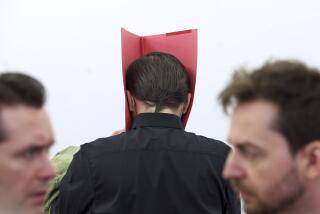Graffiti artist’s past is tagging behind him
For years Cristian Gheorghiu craved the thrill of the chase. Spray-paint can in hand, he lived on the edge, always a step ahead of the law.
His canvas was L.A.’s lampposts, brick walls and concrete riverbeds where he scrawled ragged images and his own nickname, “Smear” — probably thousands of times.
The graffiti made him a subculture sensation. Fans compared his art to that of another graffiti artist, the critically acclaimed Jean-Michel Basquiat.
But just as the East Hollywood graffiti artist’s career was taking off, his past has threatened to overtake him.
First came jail and a whopping fine. Now, City Atty. Carmen Trutanich is seeking a one-of-a-kind court injunction to bar Gheorghiu from profiting from art bearing his telltale “tag.”
The American Civil Liberties Union calls the lawsuit an assault on artistic freedom. For Gheorghiu, it is something more: an attack on his cherished outlaw persona.
Smear “is the beast over there, and I’m over here,” said Gheorghiu, 34. “I’m not going to turn my back on it,” but “you got to evolve.”
*****
The slight, bearded Gheorghiu is the most recent in a long line of graffiti writers to wow the art scene.
Traditional graffiti, a bold style of writing done with spray paint or markers, harks back to at least the 1920s. Its current artistic form developed in the 1970s, when New York City’s painted subway cars became iconic. Today, the work of people once considered vandals can be found in chic galleries, auction houses and even suburban shopping malls.
Some former miscreants have become household names. Basquiat, the internationally known neo-expressionist artist, burst onto the New York art scene in the late 1970s. Today, a piece by Banksy — the secretive British graffiti artist nominated this year for a best documentary Oscar — may command hundreds of thousands of dollars. Shepard Fairey’s art is found on the youth-oriented Obey line of clothing.
Graffiti writers have had an “incredible influence on culture, music and art,” said Roger Gastman, one of the authors of “The History of American Graffiti,” to be released soon by Harper Collins.
Smear has not yet achieved the stature of a Basquiat or Banksy, but his path is similar.
Born in Bucharest, Romania, he grew up in the ‘80s in then-rough East Hollywood. He drifted into gang life as a teenager, he said. By his early 20s, graffiti had become his obsession.
He held various jobs: stocking bottles at a bar, working in a retail clothing shop and a video store.
But this was a backdrop to his shadowy after-dark existence. Sometimes he traveled with tagging groups with brazen names: Racing Toward Hell, Metro Transit Assassins (or MTA). Mostly he spent his nights alone with a small backpack and a few cans of Coors and beef jerky, spraying poles, newspaper boxes and rusty utility boxes.
He hopped gates and hunted for forgotten access ladders. He dodged guard dogs and crunched across gravel roofs, always searching for that blank surface that, in his words, “screamed to be hit.”
There were moments of chest-pounding fear. But he also found peace, perched on some high outcropping, smoking a Parliament cigarette, gazing down at the city lights as treetops swayed in the breeze.
“It is a Peter Pan existence.… There is nothing like it in the world,” he said. “It is better than sex. It is better than drugs. It is just you and the city and your thoughts.… I don’t know if it is some primitive instinct or what. It just feels right.”
His repertoire quickly expanded from tags with markers and stickers to characters and his trademark, shadowy depiction of his own face.
By his late 20s, he had begun to make his first mixed-media pieces on canvas. He was living and painting in a court apartment off Normandie Avenue in East Hollywood. His paintings were unique renderings of human forms with vivid colors and rough, emotional strokes.
He developed a following. Soon he was living a dual life: graffiti painter by night, budding artist by day.
His work was noticed by artsy folks in Silver Lake and downtown Los Angeles. In 2006, he made his professional debut when an art show in San Francisco included his work. A gallery in Long Beach followed suit. After that, his canvases were exhibited in L.A., Ventura, Philadelphia, Berlin and Bucharest. There were group shows and solo shows.
Anna Bermudez, curator of collections at the Museum of Ventura County, said Gheorghiu’s art is a reflection of his urban life. In 2009 the museum exhibited what she called his almost folk art-like pieces in a show titled “Immigration to Integration.”
Mayra Baligad, owner of the popular Monkeyhouse Toys & Art Gallery in Silver Lake, said that like Basquiat, Gheorghiu “is one of most honest artists out there. He has not got any formal artist training and his work is raw.”
*****
Despite the accolades, Gheorghiu’s late-night obsession was taking a toll. A series of tagging-related misdemeanor arrests beginning in 1999 cost him his day job as a special-education aide at an elementary school. He trained as a pharmacy technician, but his criminal record made it hard to find that kind of work. He manned the front desk at a 24-hour porn show and worked as a movie extra.
In 2007, Gheorghiu’s problems came to a head with his first adult felony arrest. Responding to Smear’s graffiti on buses, L.A. County sheriff’s deputies raided his home. A graffiti vandalism conviction resulted in a 40-month suspended prison sentence, three years’ probation and about $28,000 in restitution for scrawling on buses.
Gheorghiu remains on probation because he has paid off only about $5,000 of his fines.
He says he stopped vandalizing property after his conviction. Today, he insists, his only artwork is created in a studio, with larger pieces fetching $2,000 to $2,500. Art “is my way of making amends,” he said.
*****
But his trouble with the law didn’t end. When his old tagging crew was suspected of creating a quarter-mile-long MTA tag in the Los Angeles River, Gheorghiu was caught in the ensuing police sweep.
He spent three days in jail in 2009. Charges were never filed.
But in 2010, the city attorney sued him and nine others. The suit seeks at least $1 million in penalties and a civil injunction that would forbid many activities, including making money from work emblazoned with their street names.
City attorneys point out that Gheorghiu advertises his work as “crime transformed into art.” They say he once told an investigator that sheriff’s evidence stickers placed on his confiscated paintings would increase their value.
Their suit also argues that Gheorghiu’s graffiti served as free publicity, giving him an unfair advantage over legitimate artists — a violation of state laws governing fair competition.
“We don’t want to take away anyone’s living, but we don’t want anyone profiting from their crimes,” Deputy City Atty. Travis Austin said.
Tagging, Austin said, costs millions of dollars annually to clean, detracts from the city’s appearance and property values and makes residents fearful and insecure. “Graffiti,” he asserted in a court proceeding earlier this month, “is not entitled to 1st Amendment protection.”
But Peter Bibring, an attorney with the ACLU of Southern California who represents Gheorghiu and one other defendant, said the city attorney is seeking to restrict artists’ expression by limiting what Gheorghiu’s canvases can contain.
Bibring also objects to parts of the lawsuit modeled on gang injunctions that would subject the defendants to a lifelong curfew and limit their movements. “They are seeking to punish him for turning his life around,” Bibring said.
The city’s legal efforts against Gheorghiu infuriate gallery owner Baligad. She said Los Angeles needs to celebrate its young artists, not persecute them. “It is simply wrong for the city to go after him,” she said.
For Gheorghiu, the lawsuit has triggered a kind of artistic identity crisis. Police raids have left him so rattled that he has seen a therapist to deal with the anxiety. He admits to some self-loathing and paranoia. He has considered shedding his tagger alter ego and for the first time has signed a few pieces without his nickname.
But he also knows that being an outlaw is part of his artistic appeal and that his audience may not follow him if he is no longer the shadowy Smear. He said he has sold a few of the unsigned pieces but has stuck with the nickname for all his promotions.
Silver Lake collector Art Santillan, 36, would never have heard of him if not for his outlaw graffiti. “He is well-known on the street,” Santillan said. “I used to see his stuff everywhere.”
Unlike the city attorney, Santillan liked seeing “Smear” scrawled around town, and later bought 10 of his pieces: “His artwork is a smack in the face,” he said.
More to Read
Start your day right
Sign up for Essential California for news, features and recommendations from the L.A. Times and beyond in your inbox six days a week.
You may occasionally receive promotional content from the Los Angeles Times.







